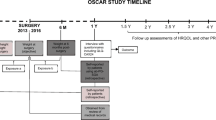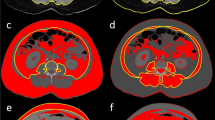Abstract
Background/Objectives:
Cachexia is a state of involuntary weight loss. The latest generic definition states that aside from weight loss, patient needs to fulfill additional criteria to be diagnosed with cachexia. New, condition-specific definitions also take the weight loss as a principal criterion, and additional criteria are not mandatory but are a part of further assessment. The aim of this study was to reveal the influence of additional criteria on the prevalence of cachexia in patients with various diseases linked to cachexia. Owing to this, we used the last generic definition. Possible differences in clinical presentations of patients with documented weight loss, with the respect of fulfillment of additional criteria were sought.
Subjects/Methods:
Clinical and anthropometric data on 137 consecutive patients with malignant diseases and chronic heart failure from a single institution were collected.
Results:
Fourty-two (30.6%) patients had >5% weight loss in the last 12 months. Only 30 (21.8%) of them were found to meet additional three out of five criteria proposed by the new definition. This observed difference in the prevalence of cachexia diagnosed with or without using additional criteria was found to be significant (P=0.0006). Comparison of clinical/laboratory data showed significantly higher levels of C-reactive protein and lower levels of albumin, as well as lower measurements of mid-arm circumference, triceps and suprailiac skinfolds in patients that fulfilled additional criteria. Survival analysis did not show reduced survival of patients fulfilling additional criteria.
Conclusions:
Additional criteria ‘reduce’ the prevalence of cachexia. They are indicative of differences in laboratory and clinical features of cachectic patients but do not influence their survival.
This is a preview of subscription content, access via your institution
Access options
Subscribe to this journal
Receive 12 print issues and online access
$259.00 per year
only $21.58 per issue
Buy this article
- Purchase on Springer Link
- Instant access to full article PDF
Prices may be subject to local taxes which are calculated during checkout


Similar content being viewed by others
References
Doehner W, Anker SD . Cardiac cachexia in early literature: a review of research prior to Medline. Int J Cardiol 2002; 85: 7–14.
Bennani-Baiti N, Walsh D . What is cancer anorexia-cachexia syndrome? A historical perspective. J R Coll Physicians Edinb 2009; 39: 257–262.
Morley JE, Thomas DR, MMG Wilson . Cachexia: pathophysiology and clinical relevance. Am J Clin Nutr 2006; 83: 735–743.
Danaei G, Vander HS, Lopez AD, Murray CJ, Ezzati M . Causes of cancer in the world: comparative risk assessment of nine behavioral and environmental risk factors. Lancet 2005; 366: 1784–1793.
Sharma R, Succinct M, London R, Kacevska M, Liddle C, Clarke SJ . Systemic inflammatory response predicts prognosis in patients with advanced stage colorectal cancer. Clin Colorectal Cancer 2008; 7: 331–337.
Otaki M . Surgical treatment of patients with cardiac cachexia. Chest 1994; 105: 1347–1351.
Lainscak M, Filippatos GS, Gheorghiade M, Fonarow GC, Anker SD . Cachexia: common, deadly, with an urgent need for precise definition and therapies. Am J Cardiol 2008; 101: 8E–10E.
Evans WJ, Morley JE, Argiles J, Bales C, Baracos V, Guttridge D et al. Cachexia: a new definition. Clin Nutr 2008; 28: 793–799.
Fearon K, Strasser F, Anker SD, Bosaeus I, Bruera E, Fainsinger RL et al. Definition and classification of cancer cachexia: an international consensus. Lancet Oncol 2011; 12: 489–495.
Dickstein K, Cohen-Solal A, Filippatos G, McMurray JJV, Ponikowski P et al. ESC guidelines for the diagnosis and treatment of acute and chronic heart failure 2008. Eur Heart J 2008; 29: 2388–2442.
Schlussel MM, dos Anjos LA, de Vasconcellos MTL, Kac G . Reference values of handgrip dynamometry of healthy adults: a population based study. Clin Nutr 2008; 27: 601–607.
Kuczmarski MF, Kuczmarski RJ, Najjar M . Descriptive anthropometric reference data for older Americans. J Am Diet Assoc 2000; 100: 59–66.
Bishop CW, Bowen PE, Richey SJ . Norms for nutritional assessment of American adults by upper arm anthropometry. Am J Clin Nutr 1981; 34: 2530–2539.
Castillo-Martinez L, Orea-Tejeda A, Rosales MT, Ramirez EC, Gonzales VR, Laufente EA et al. Anthropometric variables and physical activity as predictors of cardiac cachexia. Int J Cardiol 2005; 99: 239–245.
Vigano A, Donaldson N, Higginson IJ, Bruera E, Mahmud S, Suarez Almazor M . Quality of life and survival prediction in terminal cancer patients. Cancer 2004; 101: 1090–1098.
Anker SD, Steinborn W, Strassburg S . Cardiac cachexia. Ann Med 2004; 36: 518–529.
Fearon KC, Voss AC, Husted DS . Definition of cancer cachexia: effect of weight loss, reduced food intake and systemic inflammation on functional status and prognosis. Am J Clin Nutr 2006; 83: 1345–1350.
Muscaritoli M, Anker SD, Argiles J, Aversa Z, Bauer JM, Biolo G et al. Consensus definition of sarcopenia, cachexia and pre-cachexia: Joint document elaborated by Special Interest Group (SIG) ‘cachexia-anorexia in chronic wasting diseases’ and ‘nutrition in geriatrics’. Clin Nutr 2010; 29: 154–159.
Fearon K, Arends J, Baracos V . Understanding the mechanisms and treatment options in cancer cachexia. Nat Rev Clin Oncol 2013; 10: 90–99.
Vigano A, Del Fabbro E, Bruera E, Borod M . The cachexia clinic: from staging to managing nutritional problems in advanced cancer patients. Crit Rev Oncog 2013; 17: 193–303.
Letilovic T, Perkov S, Mestric ZF, Vrhovac R . Differences in routine laboratory parameters related to cachexia between patients with solid hematological diseases and patients with solid tumors or heart failure–is there only one cachexia? Nutr J 2013; 12: 6.
Tisdale MJ . Mechanisms of cancer cachexia. Physiol Rev 2009; 89: 381–410.
Kilgour RD, Vigano A, Trutschnigg B, Hornby L, Lucar E, Bacon SL et al. Cancer-related fatigue: the impact of skeletal muscle mass and strength in patients with advanced cancer. J Cachexia Sarcopenia Muscle 2010; 1: 177–185.
Moses AG, Maingay J, Sangster K, Fearon KC, Ross JA . Pro-inflammatory cytokine release by peripheral blood mononuclear cells from patients with advanced pancreatic cancer: relationship to acute phase response and survival. Oncol Rep 2009; 21: 1091–1095.
Arques S, Ambrosi P . Human serum albumin in the clinical syndrome of heart failure. J Card Fail 2011; 17: 451–458.
Martin L, Birdsell L, MacDonalnd N, Reiman T, Clandinin MT, MCCragar LJ et al. Cancer cachexia in the age of obesity: skeletal muscle depletion is a powerful prognostic factor, independent of body mass index. J Clin Oncol 2013; 31: 1539–1547.
Acknowledgements
All analyses presented in the study were done within the routine protocol of Clinical Hospital Merkur without additional sources of funding.
Author information
Authors and Affiliations
Corresponding author
Ethics declarations
Competing interests
The authors declare no conflict of interest.
Additional information
Contributors: TL gathered all the patients’ data and blood samples. TL contributed in the conception and design of the study, analysis and interpretation of the data, critical revision and final approval of the version that was submitted. RV also contributed in the conception and design of the study, analysis and interpretation of the data, critical revision and final approval of the version that was submitted in the design of the study and statistical analyses.
Rights and permissions
About this article
Cite this article
Letilovic, T., Vrhovac, R. Influence of additional criteria from a definition of cachexia on its prevalence—good or bad thing?. Eur J Clin Nutr 67, 797–801 (2013). https://doi.org/10.1038/ejcn.2013.121
Received:
Revised:
Accepted:
Published:
Issue Date:
DOI: https://doi.org/10.1038/ejcn.2013.121



